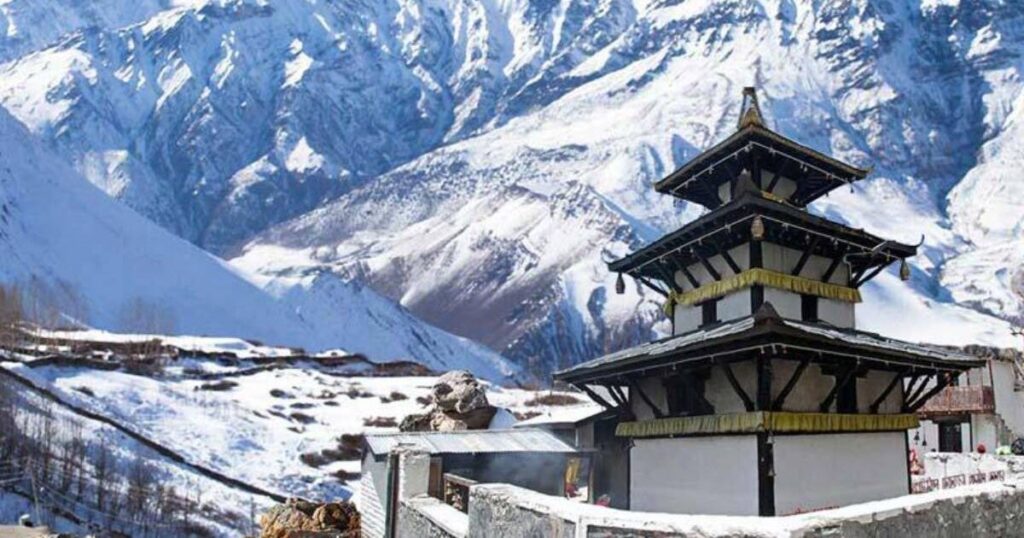Planning your sacred Muktinath yatra? Determining the best time to visit Muktinath is crucial for a spiritually enriching and logistically smooth journey. Located at a high altitude in the Himalayan ranges, this sacred temple attracts thousands of pilgrims and trekkers annually from India and around the world. Nestled in Nepal's Mustang district, this revered site experiences varying conditions throughout the year—weather, accessibility, and spiritual festivals differ significantly with the changing seasons, making the best time to visit Muktinath an important consideration for pilgrims.
Set at an elevation of 12,172 feet (3,710 meters) in the Himalayan region, Muktinath experiences dramatic weather changes throughout the year. The temple temperature ranges from sub-zero in winter to mild highs in summer, with distinct advantages and challenges in each season. Understanding these mountain climate patterns is essential for determining the best time to visit Muktinath and planning a comfortable and meaningful pilgrimage experience to this sacred destination.
Table of Contents
Best Time to Visit Muktinath : Quick Overview
The following table provides a month-by-month breakdown of what to expect when planning your Muktinath temple tour:
| Month | Temp (°C) | Precipitation | Accessibility | Visitor Flow |
|---|---|---|---|---|
| January | -8 to 2 | Low | Hard | Very Low |
| February | -5 to 5 | Low | Moderate | Low |
| March | 0 to 8 | Moderate | Good | Low |
| April | 5 to 12 | Moderate | Good | Moderate |
| May | 8 to 15 | Moderate | Good | Moderate |
| June | 10 to 18 | High | Risky | Low |
| July | 12 to 20 | Very High | Challenging | Very Low |
| August | 12 to 20 | High | Risky | Low |
| September | 8 to 17 | Moderate | Good | High |
| October | 5 to 15 | Low | Excellent | Very High |
| November | 0 to 10 | Low | Good | High |
| December | -5 to 5 | Low | Difficult | Low |
You can also explore our affordable Pilgrimage Tour Package designed for Budget Travellers.
Spring (March to May)
Spring is one of the best seasons to visit Muktinath—not too cold, not too hot, and perfect for rituals, trekking, and sightseeing.
- Daytime temperature: 10°C to 15°C
- Vibrant rhododendrons bloom along trekking paths
- Chaitra Navratri festival is celebrated
- Moderate crowds and stable transportation
- Occasional late-afternoon showers
Summer/Monsoon (June to August)
While summer sees rainfall across Nepal, Muktinath, situated in the Annapurna rain shadow, receives less precipitation than other regions.
- Temperature: 12°C to 20°C
- Green landscapes and flowing waterfalls
- Lesser crowds, more serenity
- Travel disruption risk due to landslides
- Considered highly auspicious for Vishnu devotees
Autumn (September to November)
Autumn is universally acknowledged as the best time to visit Muktinath due to its stability and clarity.
- Clear skies, stunning mountain views
- Comfortable temperature: 5°C to 15°C
- Major festivals: Dashain and Tihar
- Ideal for both spiritual seekers and families
- High tourist footfall—book early
Winter (December to February)
Winter cloaks Muktinath in snow, offering a peaceful and introspective journey for those prepared for harsh conditions.
- Daytime temperature: -10°C to 5°C
- Minimal crowds, unique snow-covered serenity
- Travel challenges due to snow-blocked roads
- Limited accommodation options
- Requires full cold-weather preparation
Best Time to Visit Muktinath: Travel Guide

Knowing how to reach Muktinath Nepal is vital when planning your visit. The journey itself can be as meaningful as the destination, with each route offering its own unique perspectives of Nepal's stunning landscapes.
By Air + Road:
- Kathmandu → Pokhara (Flight, 25 minutes)
- Pokhara → Jomsom (Flight, 20 minutes)
- Jomsom → Muktinath (Jeep/Bus, 1.5-2 hours)
By Road:
- Kathmandu → Pokhara (8 hours)
- Pokhara → Jomsom → Muktinath via Beni (2 days by Jeep)
Trekking Route:
- Via Annapurna Circuit—popular with adventure pilgrims
- Offers gradual acclimatization and breathtaking scenery
Travel Tip: Spring and autumn are the most reliable seasons for transport. Avoid peak monsoon (July-August) and extreme winter (January) due to risks of landslides and snowfall.
Muktinath Temple History: A Legacy of Liberation

The Muktinath temple history dates back over 1,500 years and bridges both Hindu and Buddhist faiths. Understanding this rich heritage enhances the spiritual significance of your visit and helps connect you with the deeper meaning behind the rituals.
Historical and Religious Significance
- For Hindus: It is one of the 108 Divya Desams dedicated to Lord Vishnu. The name "Muktinath" means "Lord of Liberation"—a sacred spot for attaining moksha.
- For Buddhists: Known as Chumig Gyatsa, it's a revered tantric site associated with Avalokiteshvara.
- Architectural Elements: The main shrine houses a gold-faced idol of Lord Vishnu
- Sacred Features: 108 bull-faced water spouts (gomukhs) symbolize purification
- Eternal Flame: Natural gas deposits create a perpetual flame that burns alongside water, representing the coexistence of elements
Muktinath Tour Package Insights: Seasonal Inclusions
Booking a Muktinath tour package? Your choice of season influences pricing, availability, and experiences. Understanding these seasonal differences helps you select the right package for your needs and expectations.
Altitude Tip: Autumn and spring offer the most comfortable altitude transition with stable weather conditions that minimize additional stressors.
Peak Seasons (Spring & Autumn)
- Full-service packages available
- Higher demand—advance booking required
- Group and private tour options
- Complete range of services and amenities
- Premium pricing structure
Off-Seasons (Winter & Monsoon)
- Lower prices, more negotiation flexibility
- Personalized attention, less crowding
- Limited service availability
- Contingency plans for weather disruptions
- Special spiritual experiences with fewer distractions
Always look for packages that include: Transportation, permits, accommodation, experienced guides, and emergency support.
Muktinath Temple Temperature: What to Pack
Prepare for drastic day-night temperature swings when visiting Muktinath. Located at an altitude of over 12,000 feet, the Himalayan climate in this region is both unpredictable and intense. Even during the best time to visit Muktinath, such as autumn (September–November) or spring (March–May), temperatures can vary by 10°C or more between day and night. While daytime may feel pleasantly cool, nighttime can drop to sub-zero levels—especially in early spring and late autumn.
| Season | Day | Night | Temperature Swing |
|---|---|---|---|
| Spring | 8–15°C | -2–5°C | ~10°C |
| Summer | 12–20°C | 5–10°C | ~10°C |
| Autumn | 5–15°C | -5–5°C | ~10°C |
| Winter | -5–5°C | -15–(-5)°C | ~10°C |
Spring/Autumn:
- Layered clothing
- Light to medium jacket
- Sun protection (hat, sunglasses, sunscreen)
- Comfortable hiking shoes
- Light gloves and scarf
Summer/Monsoon:
- Waterproof jacket and pants
- Quick-dry clothing
- Waterproof hiking shoes
- Umbrella/raincoat
- Insect repellent
Winter:
- Heavy down jacket
- Thermal underwear
- Insulated waterproof boots
- Heavy gloves, hat, and scarf
- Sleeping bag (for basic accommodations)
Muktinath Yatra: When Devotion Meets the Seasons
Your Muktinath yatra can align with key spiritual festivals that enhance the devotional experience. The timing of your pilgrimage can significantly impact its spiritual significance and the rituals you can participate in.
Key Festival Seasons
- Dashain & Tihar (September–November): Peak pilgrimage season with vibrant celebrations
- Janai Purnima (July/August): Hindu sacred thread ceremony with special rituals
- Maha Shivaratri (February): Lord Shiva celebration with unique observances
- Buddha Jayanti (May): Honoring Buddha's enlightenment with Buddhist ceremonies
Seasonal Spiritual Experiences
- Spring: Ideal for meditation and yoga practices with balanced temperatures and increasing daylight
- Summer: Despite the rains, considered auspicious by many devotees who undertake challenging pilgrimages as spiritual discipline
- Autumn: Perfect for complete ritual bathing in the 108 water spouts with comfortable temperatures
- Winter: Offers intensity through austerity, with the hardships of winter travel considered spiritually rewarding
Also you can check out our blog about the offbeat places in manali so that it can help you find the best places on your next trip.
Conclusion
The best time to visit Muktinath depends on your purpose—be it spiritual fulfillment, weather comfort, or photography. While autumn (September–November) is widely recommended as the best time to visit Muktinath, spring is a close second for those seeking colorful rhododendron blooms and calm conditions. Adventurous pilgrims and ascetics might prefer the solitude that monsoon or winter seasons bring to this sacred Himalayan site.
Frenzy Holidays ensures a smooth and enriching travel experience from start to finish. You can visit us at Haware Centurion, S07/34, Nerul East, Sector 19A, Nerul, Navi Mumbai, Maharashtra 400706. For bookings or more information, call +91 7400453140, email [email protected], or visit www.frenzyholidays.com. So pack up and explore INDIA with frenzy holidays to have an unforgettable journey.
Best Time to Visit Muktinath - FAQs
What is the absolute best month to visit Muktinath?
October is widely considered the most favorable month and the best time to visit Muktinath, with clear Himalayan skies, ideal temperature (5-15°C), stable weather conditions, excellent mountain visibility, and festive atmosphere during Dashain celebrations.
Can I visit Muktinath in winter months?
Yes, Muktinath can be visited during winter (December-February), but travelers should prepare for very cold conditions with temperatures dropping well below freezing, potential snow blockages, and limited accommodation options. Winter visits require thorough preparation and cold-weather gear.
How does the monsoon affect accessibility to Muktinath?
During monsoon (June-August), road access may be temporarily disrupted due to landslides, and flights to Jomsom often face cancellations due to poor visibility. However, Muktinath receives less rainfall than other parts of Nepal due to its location in the rain shadow area.
What is the minimum time needed for a Muktinath visit?
A minimum of 5-7 days is recommended for a round trip from Kathmandu, including necessary acclimatization time. The actual temple visit itself takes about half a day, but transportation logistics and altitude adjustment require additional time.
Are there accommodation options available year-round in Muktinath?
Basic guesthouses and teahouses remain open throughout the year in Muktinath, but many higher-end facilities close during winter (December-February) and monsoon (June-August). During peak seasons (October-November), advance booking is essential.
How does Muktinath's altitude affect visitors in different seasons?
The high altitude (12,172 feet) intensifies seasonal effects—winter feels significantly colder due to wind chill, while UV exposure is stronger year-round. The risk of altitude sickness remains constant across seasons, though symptoms may be masked by cold weather in winter.
What special festivals can enhance my Muktinath pilgrimage?
Dashain (September-October), Tihar (October-November), Janai Purnima (July-August), and Maha Shivaratri (February-March) are particularly auspicious times for a Muktinath yatra, with special ceremonies and spiritual significance.

